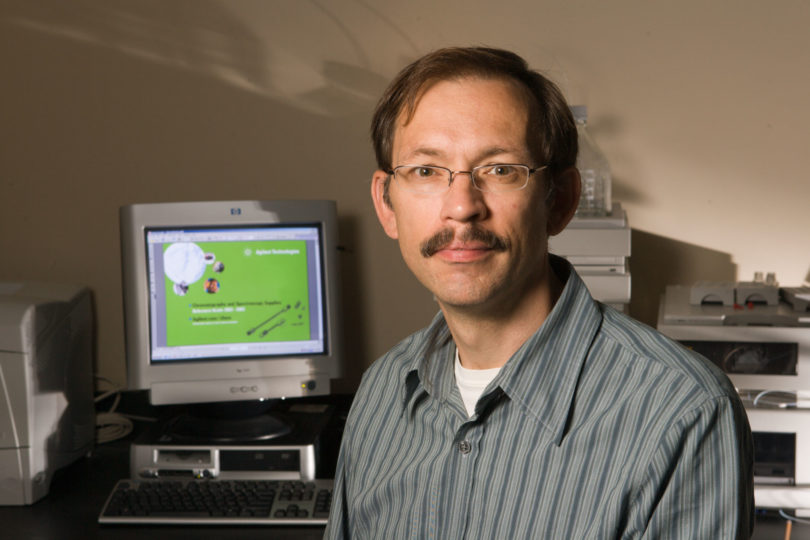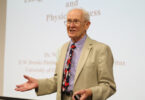Athens, Ga. – Researchers from the University of Georgia and the Mayo Clinic in Arizona have developed a vaccine that dramatically reduces tumors in a mouse model that mimics 90 percent of human breast and pancreatic cancer cases—including those resistant to common treatments.
The vaccine, described this week in the early edition of the journal Proceedings of the National Academy of Sciences, reveals a promising new strategy for treating cancers that share the same distinct carbohydrate signature, including ovarian and colorectal cancers.
“This vaccine elicits a very strong immune response,” said study co-senior author Geert-Jan Boons, Franklin Professor of Chemistry and a researcher in the UGA Cancer Center and its Complex Carbohydrate Research Center. “It activates all three components of the immune system to reduce tumor size by an average of 80 percent.”
When cells become cancerous, the sugars on their surface proteins undergo distinct changes that set them apart from healthy cells. For decades, scientists have tried to enable the immune system to recognize those differences to destroy cancer cells rather than normal cells. But since cancer cells originate within the body, the immune system generally doesn’t recognize them as foreign and therefore doesn’t mount an attack.
The researchers used unique mice developed by Sandra Gendler, Grohne Professor of Therapeutics for Cancer Research at the Mayo Clinic and co-senior author on the study. Like humans, the mice develop tumors that overexpress a protein known as MUC1 on the surface of their cells. The tumor-associated MUC1 protein is adorned with a distinctive, shorter set of carbohydrates that set it apart from healthy cells.
“This is the first time that a vaccine has been developed that trains the immune system to distinguish and kill cancer cells based on their different sugar structures on proteins such as MUC1,” Gendler said. “We are especially excited about the fact that MUC1 was recently recognized by the National Cancer Institute as one of the three most important tumor proteins for vaccine development.”
Gendler pointed out that MUC1 is found on more than 70 percent of all cancers that kill. Many cancers, such as breast, pancreatic, ovarian and multiple myeloma, express MUC1 with the shorter carbohydrate in more than 90 percent of cases.
She explained that when cancer occurs, the architecture of the cell changes and MUC1 is produced at high levels, promoting tumor formation. A vaccine directed against MUC1 has tremendous potential, Gendler said, as a preventative for recurrence or as a prophylactic in patients at high risk for particular cancers. A vaccine also can be used together with standard therapy such as chemotherapy in cancers that cannot be cured by surgery, such as pancreatic cancer.
Boons noted that MUC1 also is overexpressed in 90 percent of the subset of patients who are not responsive to hormonal therapy, such as Tamoxifen or aromatase inhibitors, or the drug Herceptin. These so-called “triple-negative” tumors are extremely aggressive and difficult to treat, Boons said, and a new treatment option is urgently needed.
“In the U.S. alone, there are 35,000 patients diagnosed every year whose tumors are triple-negative,” Boons said. “So we might have a therapy for a large group of patients for which there is currently no drug therapy aside from chemotherapy.”
Therapeutic vaccines received renewed attention last year when the Food and Drug Administration approved the first cancer treatment vaccine, a drug known as Provenge that is used to treat metastatic prostate cancer. Treatment with Provenge, which is manufactured in Georgia, requires clinicians to isolate immune cells from the patient and then to send the cells to a lab, where they are linked to a protein that stimulates the immune system. The cells are returned to the patient’s treating physician, who then infuses the drug over three treatments, usually two weeks apart.
Boons’ vaccine, on the other hand, is much simpler. It is fully synthetic, meaning that its components can be manufactured in a lab with assembly-line precision. The vaccine consists of three components-an immune system booster known as an adjuvant, a component that triggers the production of the immune system’s T-helper cells, and a carbohydrate-linked peptide molecule that directs the immune response to cells bearing MUC1 proteins with truncated carbohydrates.
Biotechnology is a key industry in Georgia, and this year Boons founded Athens-based company Viamune to help develop and commercialize the vaccine and the technologies used to create it. The company is one of nearly 30 that are affiliated with the University’s BioBusiness Center, which is an incubator for life sciences start-up companies associated with UGA.
“Companies like these have the potential to create stable, high-paying jobs that have a significant social and economic impact,” said Stefan Schulze, associate director of the Georgia BioBusiness Center. He noted that Viamune was a one four finalists selected from 40 companies at an investor’s forum hosted this year by the non-profit organization Southeast BIO.
Boons, Gendler and their colleagues are currently testing the vaccine’s effectiveness against human cancer cells in culture and are planning to assess its toxicity. If all goes well, they anticipate that phase I clinical trials to test the safety of the vaccine could begin by late 2013.
The vaccine represents nearly a decade of work on the part of Boons and his team. A 2007 study demonstrated the vaccine’s effectiveness in another mouse model, and Boons is cautiously optimistic about his most recent results. Although promising results in mice often don’t translate to humans, Boons said he is confident that vaccines that target the specific carbohydrate signatures of cancer cells will ultimately play an important role in the treatment of the disease.
“We are beginning to have therapies that can teach our immune system to fight what is uniquely found in cancer cells,” Boons said. “When combined with early diagnosis, the hope is that one day cancer will become a manageable disease.”
In addition to co-senior authors Boons and Gendler, the co-first authors on the paper are Vani Lakshminarayanan at the Mayo Clinic in Arizona and Pamela Thompson at UGA. Additional authors include Margreet Wolfert and Therese Buskas at UGA and Judy Bradley, Latha Pathangey, Cathy Madsen and Peter Cohen, M.D. at the Mayo Clinic.
The National Cancer Institute, the Mayo Breast Specialized Program of Research Excellence Grant and the Mayo Pancreas SPORE Grant funded the research.







